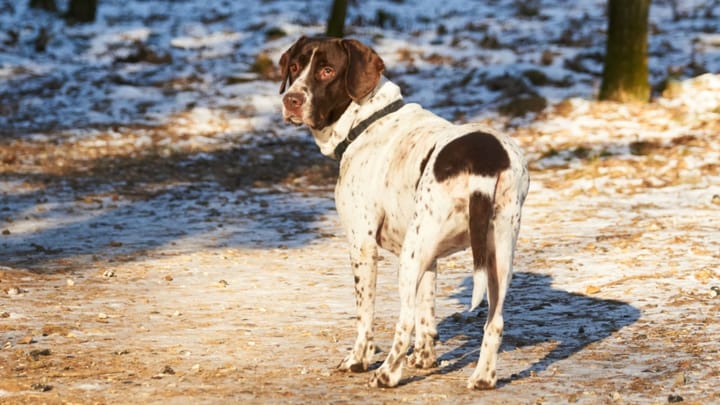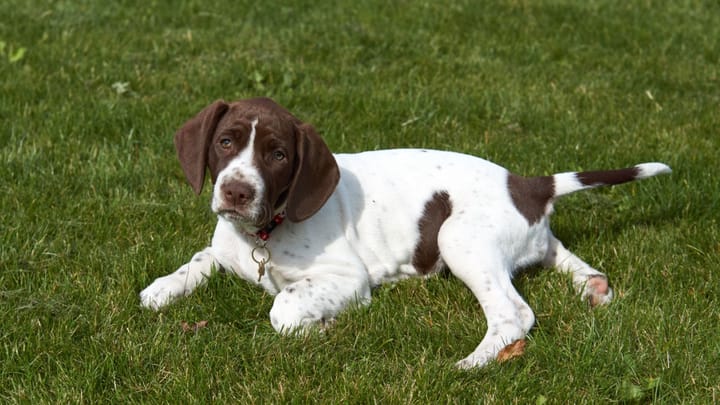Old Danish Pointing Dog
Other names : Old Danish Bird Dog, Gammel Dansk Hønsehund


The Old Danish Pointer is a solidly built dog belonging to the agile and intelligent Pointer group of dog breeds. The dog is still used in some parts of the world as a hunter because of its excellent sense of smell and ability to move almost silently across the ground. The usual prey of the Old Danish Pointer is avian.
|
Life expectancy |
The Old Danish Pointing Dog has a life expectancy of between 11 and 13 years |
|
Temperament |
|
|
Size |
Medium
|
|
Adult size |
Female
Between 20 and 22 in
Male
Between 21 and 24 in
|
|
Adult weight |
Female
Between 57 and 68 lb
Male
Between 66 and 77 lb
|
|
Coat colour
White with large brown patches and small brown specks or a mixture of both. |
White Brown |
|
Type of coat
Smooth, short-haired, single coat. |
Short |
|
Eye colour
Dark brown |
Brown
|
The Pointer is traditionally employed to locate game. Its three main skills of hunting are:
1. To point (the location of prey)
2. To honour (its instructions)
3. To retrieve (dead or wounded game)
More details about the Old Danish Pointing Dog
Old Danish Pointing Dog: Origins and history
The Old Danish Pointer is thought to have come about as a breed following the merger of several other farm dogs over the course of eight generations of breeding. The recognisable breed is said to have arrived in 1710 in northern Jutland (modern-day Denmark).
Physical characteristics of the Old Danish Pointing Dog
A strong and solid dog is the Old Danish Pointer. It is a well-proportioned dog with large feet ideally suited to move quietly and effortlessly across marshy land. The male of this breed is considerably more muscular than the female.
FCI classification of the Old Danish Pointing Dog
-
Group 7 - Pointing Dogs
-
Section 1 : Continental Pointing Dogs
Old Danish Pointing Dog: Characteristics
Old Danish Pointing Dog: Behaviour
Training a Old Danish Pointing Dog
The dog is reasonably easy to train. However training must be done properly and consistently and at all times the trainer must make an effort to hold the attention of the Pointer.
Old Danish Pointing Dog: Lifestyle
Breed compatibility Old Danish Pointing Dog
Old Danish Pointing Dog: Purchase price
We do not have enough data to set an average price for an Old Danish Pointing dog. You’re also looking at between £150 to £190 per month to care for this dog.
Old Danish Pointing Dog: Shedding
Average
Pointers moult only a moderate amount and may not excite a human allergic reaction.
Old Danish Pointing Dog: Grooming
Minimal grooming is required of the Old Danish. Half an hour each week of brushing keeps the dog’s coat well-conditioned. Use a slicker brush and metal comb. It is worthwhile to examine the ears of the Pointer on a regular basis to check for mites, fungal infections and a build-up of wax.
Old Danish Pointing Dog: Health
11 to 13 years
This is an active and courageous dog that likes nothing better than a day of outdoor exploration.
The short coat of the Old Danish Pointer allows it to be more tolerant of hot temperatures than most.
The Old Danish Pointer is robust enough to withstand walks in the snow and rain, but care should be taken after cold walks to dry the dog’s coat.
Weight gain is not usually a feature of a well-exercised Pointer. But if your Pointer is not exercised as regularly as it should be and is fed too much human or substandard food it will quickly become obese.
- Cataracts
- Entropion
- Gastric Dilatation Volvulus
- Hip dysplasia
- Hypothyroidism
- Progressive retinal atrophy
- Wobbler Syndrome
Do you want a Old Danish Pointing Dog dog ?
Oh no...
There are no Old Danish Pointing Dog adoption profiles at the moment...




